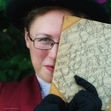Patricia Meredith's Blog, page 11
September 2, 2021
I LOVE Libraries!

Libraries will always hold a special place in my heart.

In my junior year in high school, I was encouraged to intern somewhere in a job shadow. This turned into working at my local public library for two years, which then led to my doing a work-study at my college, Whitworth University, until graduation.
Working in libraries taught me many things about myself, the biggest one being that I am definitely an INFJ: I like to work alone, in the quiet, with nothing but the smell and touch of books to keep me company, and I enjoy organizing things to an enormous degree—I actually like cataloging and reshelving.
One of the things I always worried about/felt guilty about was my tendency to check out books from the library rather than purchase them. After all, books cost money and as much as I’d love to buy All The Books, sometimes you just can’t. I often worried that by doing so, I wasn’t supporting the author, which I naturally want to do because if you support an author, they write more books.
I didn’t learn until only recently that you support authors by checking out their books from the library!

There are three basic ways that libraries obtain books:
One Copy, One UserThe first is “One Copy, One User,” which is your basic library model for print books, but it can also apply to ebook and audiobook formats. This means, the library buys one copy of a book to lend, which means if someone has it checked out, you have to put the book on hold and add your name to a waitlist to get a copy.
The author is, therefore, paid for every copy of the book the library owns, in any format. I’ll let you in on a secret, too: publishers charge libraries more for copies of books to compensate for multiple people reading one copy.
The more people who request the book, the more copies the library is going to purchase to meet the demand! So never hesitate to request a book you’re interested in at your library.
Cost Per CheckoutThe “Cost Per Checkout” model, however, allows the library to offer unlimited copies of the ebook and audiobook. Instead of paying for one copy, they are allowed to offer the book in their system, and then they have to pay a much, much lower cost (usually about 1/10th of the price) for each checkout of the book. This is very helpful to libraries because now they can offer All The Books but only pay for the ones that actually get checked out.
This is also good for authors like me who are independent/self-pub because it means my book is available everywhere if people just go looking for it, and even if they aren’t looking for it, they might stumble across it.
Under this model, the author is paid per checkout, which means if you check out the book multiple times (whether it’s because you didn’t finish it the first time or because you love it so much you want to read it again) every time you check it out, the author gets paid.
DonationsLibraries love donated books. It’s how they got started and it’s how they continue to thrive. Although it’s not possible to donate an ebook or audiobook (unless it’s available on CD), print books are always welcome.
Please, buy a copy of Butcher, Baker, Candlestick Taker to donate to your library! That’s an incredible way to support both your library and me, the author, while also helping others to find a book you know they’ll enjoy!
 So now you’re wondering, how do I request Butcher, Baker, Candlestick Taker from my library?
So now you’re wondering, how do I request Butcher, Baker, Candlestick Taker from my library?Libraries generally make it super simple to request a book. You’ll need to go to your library’s website to find out how they prefer to be notified. For example, the Spokane Public Library has a form you can fill out online to request the book.
Libby, which is an app run by Overdrive, offers a great step-by-step web page that’ll walk you through how to request Butcher, Baker, Candlestick Taker through your local library!
 Butcher, Baker, Candlestick Taker is available on Spokane County Library’s Libby! Place a hold on it in ebook or audiobook today!Does your library have my book?
Butcher, Baker, Candlestick Taker is available on Spokane County Library’s Libby! Place a hold on it in ebook or audiobook today!Does your library have my book?Let me know in the comments here or on social media if your library is carrying Butcher, Baker, Candlestick Taker!
If not, request it!
If they have it, put it on hold!
And finally, tell everyone you know to do the same! 
Keep in mind that often a library may not purchase a book until someone has requested it! And the more people who request the book, the more copies the library is likely to order to meet the interested patrons!
 Butcher, Baker, Candlestick Taker is available through the Spokane County Library! Place a hold on it in your favorite format today so you can be the first to check it out when it releases on October 4!
Butcher, Baker, Candlestick Taker is available through the Spokane County Library! Place a hold on it in your favorite format today so you can be the first to check it out when it releases on October 4!As Neil Gaiman once wrote, “[D]on’t ever apologise to an author for buying something in paperback, or taking it out from a library (that’s what they’re there for. Use your library). Don’t apologise to this author for buying books second hand, or getting them from bookcrossing or borrowing a friend’s copy. What’s important to me is that people read the books and enjoy them, and that, at some point in there, the book was bought by someone. And that people who like things, tell other people. The most important thing is that people read…”

I hope this post helped you to see how you can support your favorite authors and your local library at the same time! Next time, book clubs…
Butcher, Baker, Candlestick Taker is available for pre-order! Visit linktr.ee/pmeredithauthor to find links to All The Things: pre-order the book, watch the book trailer, news interviews, newsletter, social media, and more.
Thank you, Dear Readers!
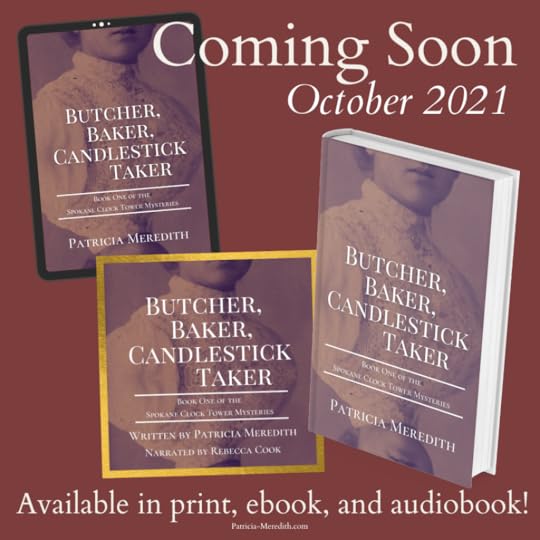
The post I LOVE Libraries! appeared first on Patricia Meredith, Author.
August 12, 2021
Spokesman-Review Newspapers that Inspired Events in the Spokane Clock Tower Mysteries
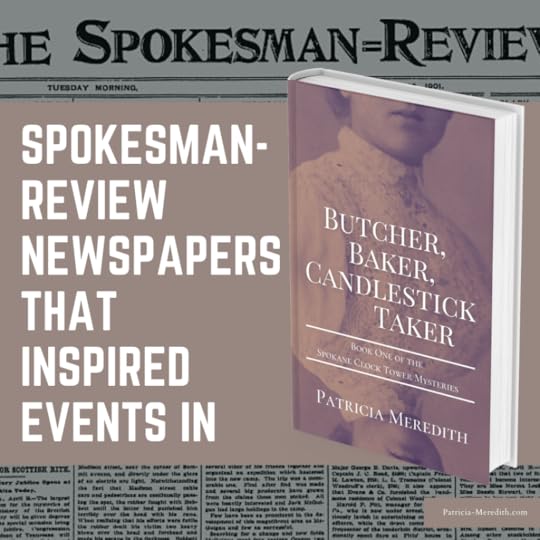
The Spokesman-Review and The Chronicle were the main newspapers of 1901 Spokane. Both were owned by William H. Cowles by 1901, who moved them all into the Review Building, which can still be visited today.
As I may have mentioned before, I love traveling down the rabbit holes of researching history, and the best place of all for that is within the pages of newspapers sharing the news and opinions of the day. It’s without a doubt one of the best resources we have for peering into the minds of people who lived in the past.
To that end, I thought it’d be fun to share a list of the corresponding Spokesman-Review editions published on the dates in which my books take place!
As you flip through them, you’ll notice the articles that inspired many of the events in the book. Some of them may even be mentioned or “read” by the characters…
Butcher, Baker, Candlestick TakerMore will be added as new books in the series are released.
Butcher, Baker, Candlestick Taker is the first in the Spokane Clock Tower mysteries.
To be the first to hear updates, sign up for my newsletter here! Or follow me as @pmeredithauthor on Instagram, Facebook, and Goodreads.

The post Spokesman-Review Newspapers that Inspired Events in the Spokane Clock Tower Mysteries appeared first on Patricia Meredith, Author.
July 29, 2021
The Campbell House
And how it inspired the Spokane Clock Tower Mysteries.
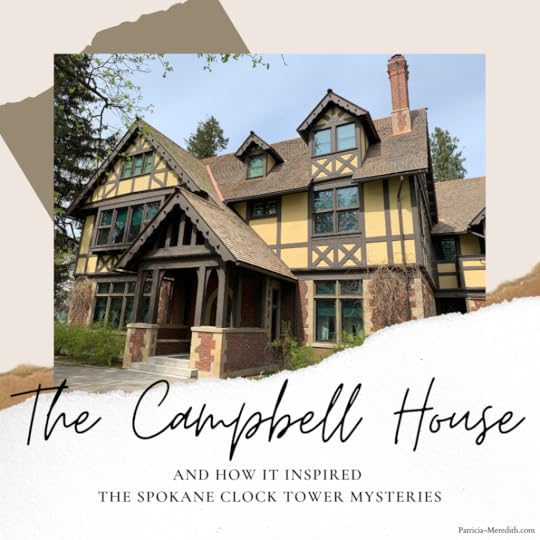 It all began with a door.
It all began with a door.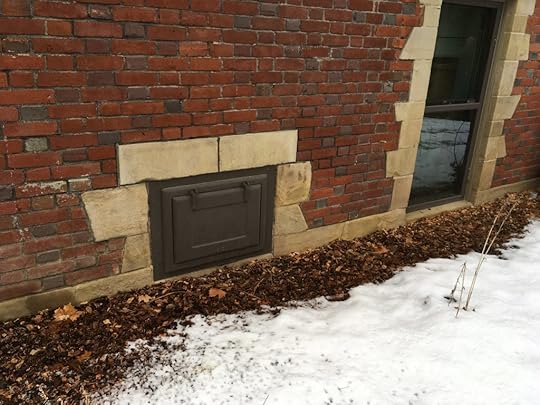
On my first tour of the Campbell House, back in 2017, the docent pointed out this simplistic door, saying it was a wood chute for the groundskeeper. He would chop wood or have it ordered in, and then deliver the wood via the chute to the basement where the furnace was stored, along with stacks and stacks and stacks of cordwood.
“There’s no lock,” I pointed out.
The docent said there was a door at the bottom of the shaft inside that would have been kept locked.
But in my mind I was already thinking about the Red Rogue, the thief who’d featured in the first draft of my mystery I’d written a couple years prior. (You can also read about the Red Rogue in my short story “Escapades of a Spokane Thief” by signing up for my newsletter.)
And that was all it took.

Once I knew for sure I’d be moving my historical mystery, Butcher, Baker, Candlestick Taker, to Spokane (which you can read more about here), I dove head-first into research, and the best place to start was, naturally, the Campbell House.
Built in 1898 by Kirtland Cutter, the Campbell House has been refitted with all the trappings of the home circa 1910 and is available for visits and tours. At Christmastime, it comes to life with actors playing roles of people who’ve lived in the house over time. It is located next to the Northwest Museum of Arts and Culture and the Ferris Archives, which are staffed by people who were invaluable in the writing of this book.
The Campbell House is the perfect inspirational location for a story set in Gilded Age Spokane and, therefore, was a major inspiration when designing Miss Mitchell’s mansion home in Butcher, Baker, Candlestick Taker. Below are a few pictures I took on my tours of items and rooms that inspired scenes in the book, along with the quotes.
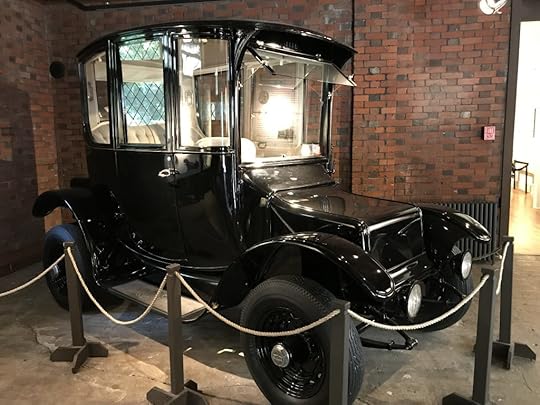

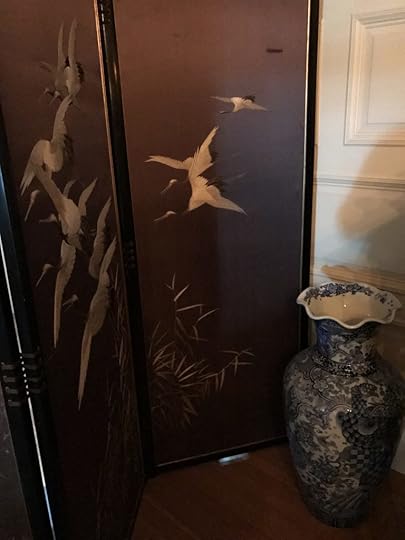

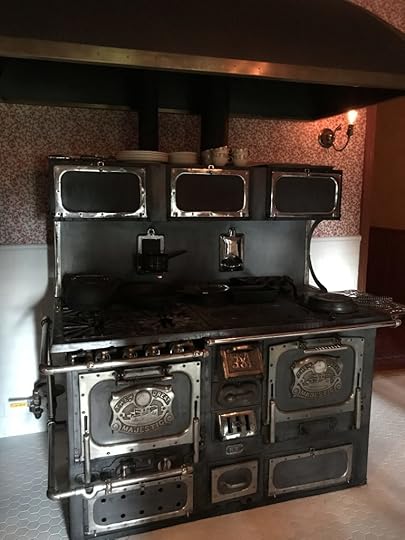
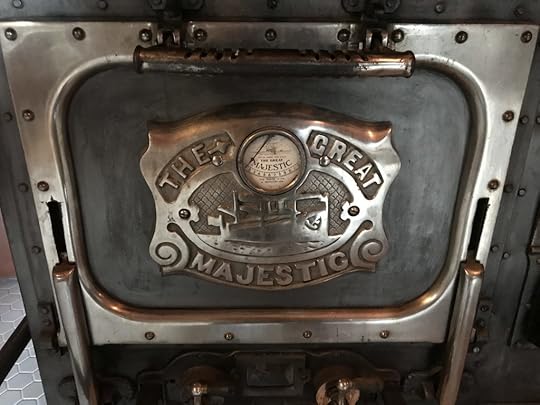
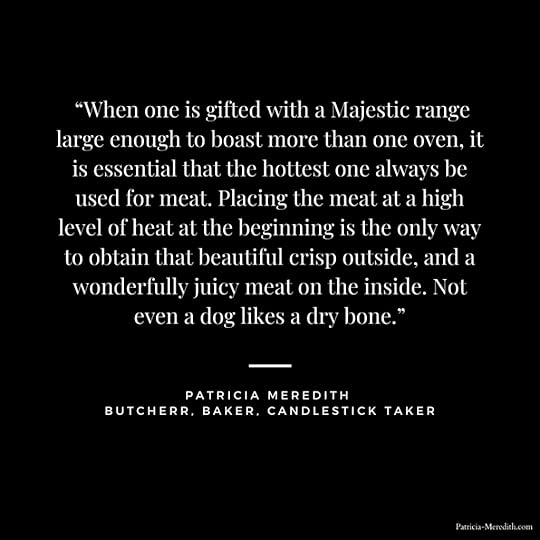


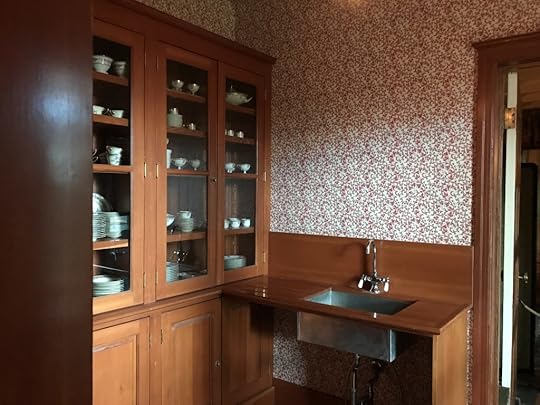

The Campbells themselves are incredibly interesting people, and I look forward to sharing more about them in the sequel to Butcher, Baker, Candlestick Taker…
But for now, if you’re interested in hearing more about the research behind the first book in the Spokane Clock Tower Mysteries, or in being the first to receive updates on the release of the book, please do me the honor of following me as @pmeredithauthor (Facebook, Instagram, and Goodreads).
Also, don’t forget to sign up for my newsletter to get a taste of my writing by reading my short story Escapades of a Spokane Thief!
Thank you for reading!
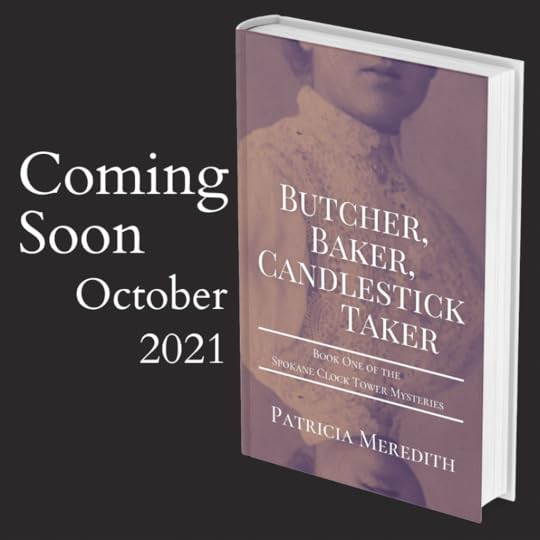
The post The Campbell House appeared first on Patricia Meredith, Author.
July 8, 2021
News Clippings: Clock Tower

Below I’ve collected a series of clipped newspaper articles referencing the timeline of the building of the Great Northern Railroad Depot and its iconic clock tower, which heavily influenced the events that unfold in the Spokane Clock Tower Mysteries, beginning with the first book, Butcher, Baker, Candlestick Taker. The clock tower is the basis for the timeline I’ve created for the book series. The books open on April 15, as the finalizations are coming into place for the building of the depot, which would span over the course of the next year, ending with the dedication of the clock on June 20, 1902.
Chronicle 30 Oct 1900The front page article includes an extensive description of what the depot would look like once built.




 Chronicle 12 Feb 1901
Chronicle 12 Feb 1901“Joseph C Overbeck arrived at Hillyard yesterday to take the position of operator at the Great Northern depot.”
Spokesman-Review 18 Apr 1901“The cause of the delay in construction of the Great Northern depot in this city was explained yesterday by one of the visiting officials. Over a month ago the contract was let to Tim Riordan of St. Paul, the lowest bidder, and at that time it was announced that work would begin at once.… Mr. Riordan failed to enter into the formal contract, and after waiting for him to do something, the officials relet the contract. The second lowest bidders got the contract. They are G.A. Johnson and Co. of St. Paul. A representative of the firm is said to be on his way west to arrange for the early starting of work.… Building operations at the depot site might have been interfered with during the construction of the steel bridges, but this latter work will be out of the way this week in that vicinity. Nothing will then interfere with rush work on the depot building.”
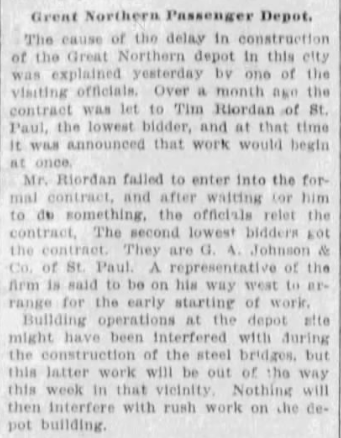 Spokesman-Review 8 May 1901
Spokesman-Review 8 May 1901Thomas refers to this article about the Great Northern depot: “finest depot building west of St. Paul.”
“Work on the Great Northern passenger depot will begin this morning under direction of Contractors GA Johnson & Son of Chicago. A gang of men will be set to work on the rock excavation preparatory to placing the foundation, the material of which will be shipped in at once.… The principal change was in the arrangement of the steel and iron work, and the elimination of the terra cotta work, which was the most expensive feature and did not add materially to the beauty of the building.… Mr. Johnson…will visit Spokane about once a month during the progress of the work and will be here continuously during the finishing touches next fall.”


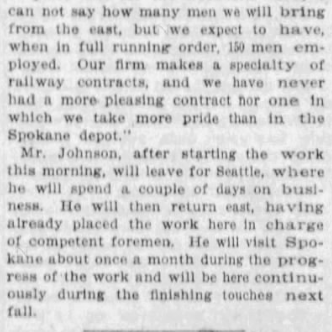 Spokesman-Review 15 May 1901
Spokesman-Review 15 May 1901“We are going to put up a temporary depot just east of the Washington street bridge, and will begin on it within a week. It will be a cheap structure, not costing over $1000, and we hope not to have to use it for very long.”
 Spokesman-Review 19 May 1901
Spokesman-Review 19 May 1901“Work has been started on the stone foundations for the Great Northern passenger depot.”
Spokesman-Review 14 June 1901“The SF&N and the Kootenai Valley trains, as well as those of the Great Northern, will arrive and depart from the new temporary depot just completed, on Havermale’s Island, beginning Sunday morning at 7 o’clock.”
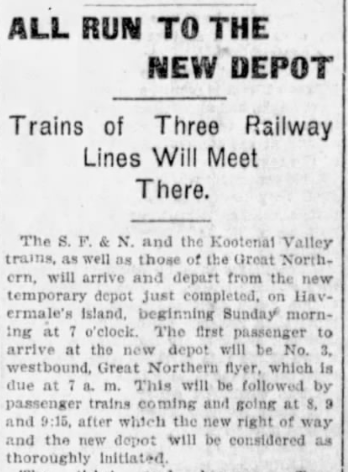 Spokesman-Review 16 Jun 1901
Spokesman-Review 16 Jun 1901“The Great Northern temporary depot on Havermale Island was the scene of hurry and bustle yesterday afternoon in preparation for today’s dedication of the building to the railway service.”
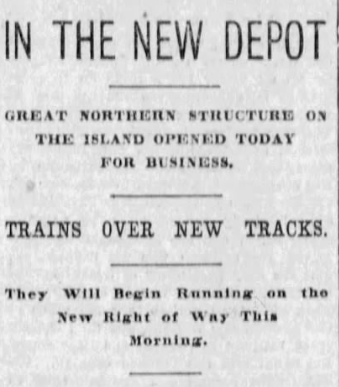
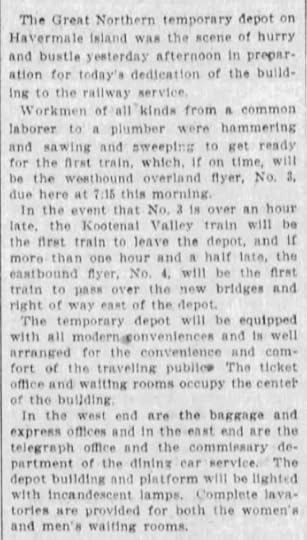
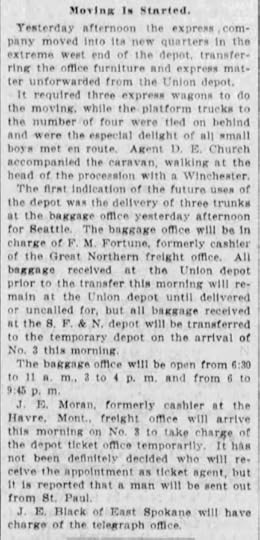 Spokesman-Review 1 Aug 1901
Spokesman-Review 1 Aug 1901“Roof timbers are being placed on the east end of the new Great Northern depot. Gates for the grade crossing on Howard street are being placed by the Great Northern.”
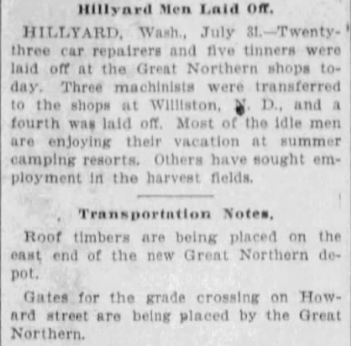 Chronicle 14 Sept 1901
Chronicle 14 Sept 1901Amidst news of McKinley’s death: “Because of the difficulty in getting the necessary steel the work on the Great Northern depot has been greatly hampered since about the first of August.”
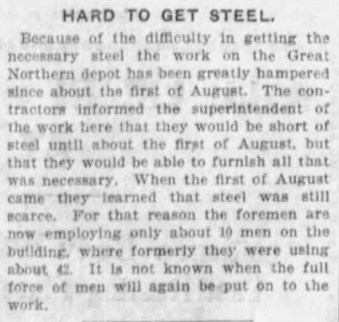 Chronicle 21 Sep 1901
Chronicle 21 Sep 1901“The Bridge on the south side of the new Great Northern depot and crossing the river at Washington street will be closed up at noon Monday for the purpose of laying the asphalt on Washington street near the bridge.”
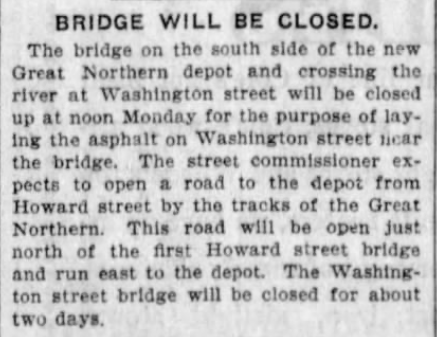 Chronicle 9 Nov 1901
Chronicle 9 Nov 1901“Great Northern Depot Work Much Delayed: Structure not to be occupied until it is nearly time for the robins.… The time for opening the new Great Northern depot will be considerably later than was at first intended. It was thought at the time of beginning the new structure on Havermale Island that the lower floor would be ready for occupancy by Christmas day. Owing to the delay in getting material, however, it will be the 1st of February, and perhaps the 1st of March before the new building is occupied at all.… On Thursday a carload of steel arrived in the city and there will be two more cars here in the near future. The arrival of this necessary material has been delayed by the big steel strike in the east, but now that it has arrived the work on the depot will be rushed as much as possible. The new boiler house, commissary and conductors’ rooms near the depot are also rapidly nearing completion, and soon the Great Northern settlement on the island will have assumed a condition which will show what the future has in store.”
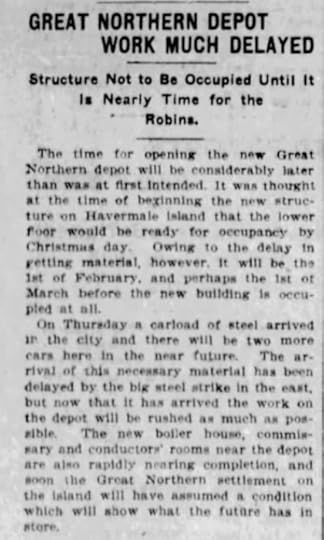 Chronicle 7 Jan 1902
Chronicle 7 Jan 1902“Charles S. Johnson, the Chicago contractor, who is building the Great Northern depot in this city, arrived in Spokane this morning. He is stopping at the Spokane.”
Spokesman-Review 25 Feb 1902″Station a Fine One”


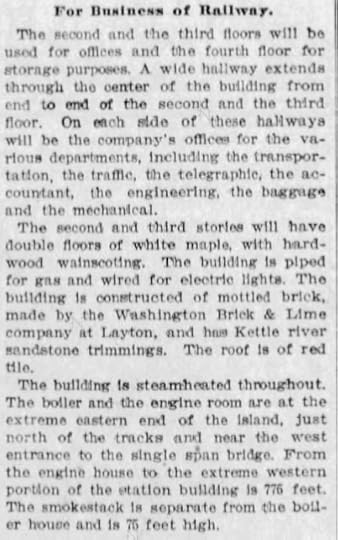
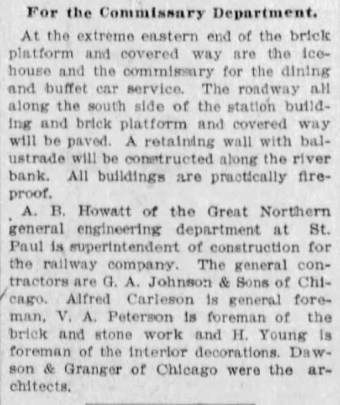 Chronicle 3 June 1902
Chronicle 3 June 1902“Work on the second floor of the new Great Northern depot is progressing well, and the Great Northern officials expect to be able to move the general offices of that road within a couple of weeks or shorter time.”
Chronicle 1 July 1902“CW Johnson of Chicago is at the Spokane. Mr. Johnson is the contractor who had the construction of the new Great Northern depot, which he turned over to the Great Northern road today.”

As you can tell, we have a lot to look forward to concerning the construction of the Great Northern Railroad Depot and clock tower in the Spokane Clock Tower Mysteries!
For the latest updates, be sure to follow me as @pmeredithauthor (Facebook, Instagram, and Goodreads).
Thank you for reading!

The post News Clippings: Clock Tower appeared first on Patricia Meredith, Author.
July 1, 2021
Historical Locations in Butcher, Baker, Candlestick Taker
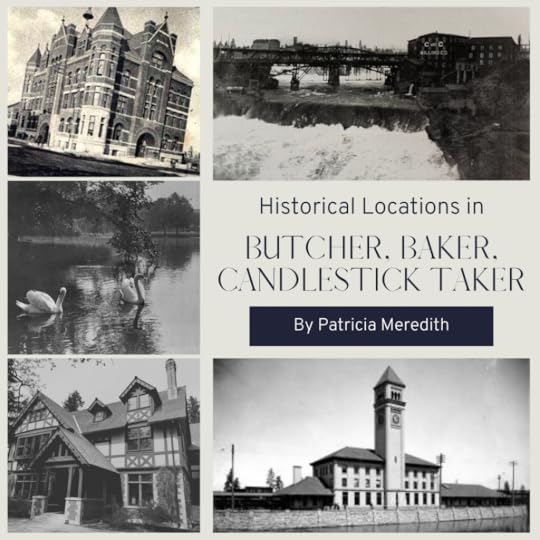
In my historical mystery series, the Spokane Clock Tower Mysteries, we are transported to 1901 Spokane.
In addition to including cameos by many real-life people from history, I wanted to make sure I included locations that were still in existence and could be visited by those who enjoyed the story and wanted to know more.
To that end, I created a map here where you can find all the streetcar routes and real-life locations I incorporated into Butcher, Baker, Candlestick Taker, the first book in the series, though I intend to add more locations as the books progress.
 Photo by the Northwest Museum of Arts and CultureThe Clock Tower
Photo by the Northwest Museum of Arts and CultureThe Clock TowerOf course, I have to start with the Great Northern Railroad Depot clock tower, which is the only part of the depot that still stands at what is now Riverfront Park.
The clock tower is the basis for the timeline I’ve created for the book series. The books open on April 15, 1901, as the finalizations are coming into place for the building of the depot, which would span over the course of the next year, ending with the dedication of the clock on June 20, 1902.
The weight-operated clock within the clock tower was designed by the Seth Thomas Company in Connecticut, though no designer is named. This allowed me the opportunity to create my own, and thus, Archie Prescot was born, a favorite character by many readers.
A complete description of the new depot can be found reported on the front page of The Spokane Daily Chronicle, October 30, 1900:





The historic property listing for the clock tower, nominated when the depot was torn down for Expo ’74, includes some other wonderful descriptions of the lost depot and clock tower:
“The building stands across the south river channel from a partially similar four-story structure, the Union Pacific station. The two, when viewed together, form a scene reminiscent of the Piazza del Duomo in Italy, except for the substitution of a reflecting river pool in place of the paved court.”
“…on a cut granite plinth (which is purported to have been imported from England). The remainder of the facade is buff-colored face brick (almost white) with granite sills, native sandstone trim, and metal ornamentation… The roof is clay tile…”
“The nine-foot diameter clock faces made it the largest timepiece in the Pacific Northwest.”
“The glass dials total over 1400 pounds. The zinc pendulum rod weighs nearly 500 pounds and is 8 ½ feet in length. The total weight comes to 7050 pounds for the entire piece. The clock was placed in service at high noon on June 20, 1902.”
Historic Property Listing for the Great Northern Railroad Depot Clock Tower
An article about Dave Randolph and his job as caretaker of the clock tower for over twenty years appeared in The Spokesman-Review November 3, 1994, entitled “Winding up the Week.” The article shared some wonderful descriptions of the inside of the clock tower:
“Randolph climbs three wooden stairways and two metal ladders, then turns a crank 99 times to hoist a 450-pound counterweight that runs the clock in the Riverfront Park Clock Tower. If neglected for eight days, the counterweight would hang at the end of its 100-foot cable and time would stop.”
“…zips up 87 stairs and rungs. Emerging through a hatchway, he straightens up in a room Alfred Hitchcock would have loved. On all four sides are the backs of huge clock faces. The reverse side of Roman numerals and 4-foot-long minute hands surround him.”
“In the center of the room is a wooden house. Inside the house is a castle of gears encased in an iron framework. A 300-pound brass pendulum releases tension second by second, swing by swing. Randolph attaches a large crank to this mechanical heart.”
“There are 26 more rungs bolted to the brick wall in this room. They lead to the wind-blown top of the tower…”
“Winding up the Week,” The Spokesman-Review, 11/3/94
 Photo by the Northwest Museum of Arts and CultureMontrose Park
Photo by the Northwest Museum of Arts and CultureMontrose ParkIn my book, Marian and Archie meet frequently at Montrose Park, which lives on but is known by another name now: Manito Park (changed in 1903).
Francis Cook, the owner of the land, named it “Montrose” because of the wide variety of wild roses. Although today there are numerous gardens within Manito—Duncan Gardens, Japanese Gardens, and Lilac Gardens, to name a few—the park would first pass through many phases, including being home to a zoo from 1905-1932.
What is today known as “the duck pond” was called “Mirror Lake,” and was large enough people would ice skate across the shallow surface in winter. The Japanese garden at Miss Mitchell’s estate was inspired by the one you can visit at Manito today. It is a beautifully quiet oasis in the middle of a bustling city, just as Marian describes:
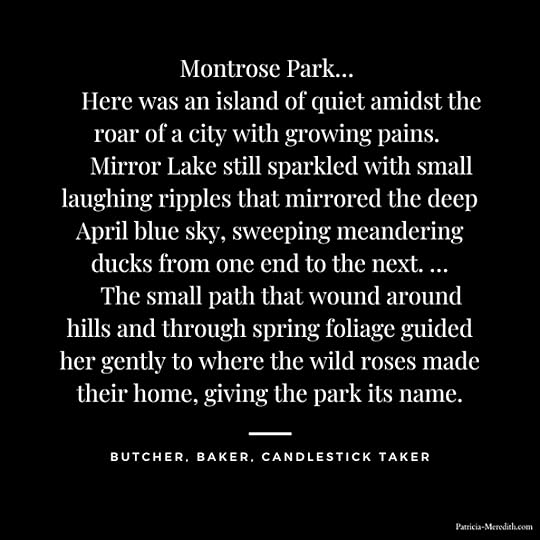
Marinus Crommelin in Dear Mother, includes a beautiful photograph he took of swans on Mirror Lake in Montrose Park.
 Image by Marinus Crommelin, 1901, used with permission by the family
Image by Marinus Crommelin, 1901, used with permission by the familyOddly enough, the now-iconic lilacs of the “Lilac City” didn’t make an appearance until 1906, which means I cannot reference them in my book unless I decide to twist history a little. According to the Spokane Lilac Festival website, “The first time a lilac bush appeared in Spokane was in 1906. Two lilac bushes were planted by J. J. Browne, one of Spokane’s early builders, at West 2226 Second Avenue (Browne’s Addition).”
Browne’s AdditionBrowne’s Addition, where Nain’s house is located, is a beautiful area of Spokane where you can still experience the Campbell House for an immersive historical tour of a Spokane home circa 1910. It is located next to the Northwest Museum of Arts and Culture and the Ferris Archives, which are staffed by people who were invaluable in the writing of my book.
The Campbell House was a major inspiration when designing Miss Mitchell’s mansion home and when describing the lifestyle of those who lived in such luxury at the turn of the century. I look forward to sharing more about the Campbells in the sequel book…



 Pictures taken by myself of the Campbell House
Pictures taken by myself of the Campbell HouseMy descriptions of the interior of homes at that time were also inspired by these photographs by Marinus Crommelin, from his visit to Spokane in 1901-1902 and collected in Dear Mother.



 Photographs by Marinus Crommelin, 1901-1902, used with permission by the familyCity Hall
Photographs by Marinus Crommelin, 1901-1902, used with permission by the familyCity Hall Pictures from a Spokane photography book Marinus Crommelin brought back with him circa 1901.
Pictures from a Spokane photography book Marinus Crommelin brought back with him circa 1901.City Hall is one of the few locations in the book that cannot be visited, as it is no longer at the location described, Howard St. and Front St., as this is currently where you can visit the 1909 Looff Carousel in Riverfront Park. The 1894 City Hall was built to house the fire department, city hall, and police department, which was located on the first floor. I was able to find the City Hall on the Sanborn Maps of 1902, however, which helped me with the placement of the police department and jail.
 Sanborn Maps, 1902Fernwell Building
Sanborn Maps, 1902Fernwell BuildingThe Fernwell Building, however, which housed the lawyer LL Westfall in 1901, as well as many other businessmen, is still located a few blocks up Howard from the old location of City Hall, and is exactly as described by Bernard.

As you can see, I had great fun incorporating real locations around Spokane into my historical mystery, Butcher, Baker, Candlestick Taker. I look forward to sharing more about the history woven into the novel.
For the latest updates, be sure to follow me as @pmeredithauthor (Facebook, Instagram, and Goodreads).
Thank you for reading!

The post Historical Locations in Butcher, Baker, Candlestick Taker appeared first on Patricia Meredith, Author.
June 24, 2021
Butcher, Baker, Candlestick Taker COVER REVEAL
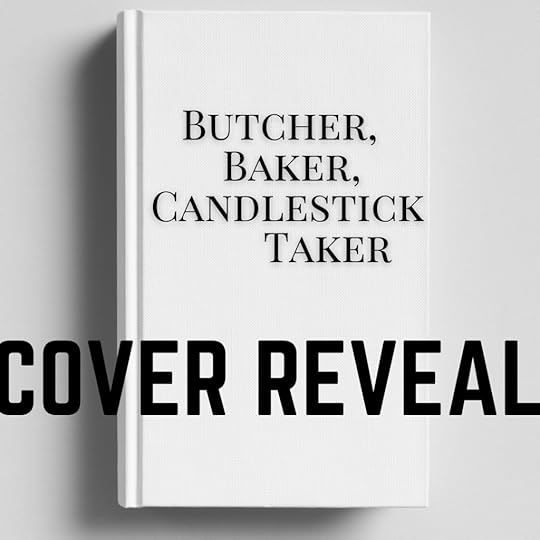
I am so excited to reveal to you all the cover for the first book in the Spokane Clock Tower Mysteries, Butcher, Baker, Candlestick Taker!
“A vivid and intense historical thriller featuring murder and mystery, mayhem and madness in 1901 Spokane.” — New York Times bestselling author William H Keith
Set in Gilded Age Spokane, Archie Prescot has traveled across the country to design the now-iconic Spokane clock tower for the new Great Northern Railroad Depot. When his talent for creating unique clock chimes connects him with a local patroness, he is thrilled, until she is discovered dead in the workshop of his new colleague.
Her grand home on the South Hill provides ample suspects, as Archie works with his lodgers, Detective Carew and his twin brother, to prove his fellow inventor and himself innocent of the crime. While on the hunt for the murderer, romance crops up when a young lady crosses his path with a mysterious past of her own. Six intersecting storylines create a cohesive look at a convoluted murder that will require all points of view to discover the truth…
And now the moment has come…
Drum roll please…
 Cover designed on Canva by Patricia Meredith
Cover designed on Canva by Patricia MeredithI’d love to hear what you think in the comments?????
Butcher, Baker, Candlestick Taker is the first in the Spokane Clock Tower Mysteries and will be available in all your favorite formats: print, ebook, and audiobook wherever books are sold. Narrator Rebecca Cook (Spokane local!) brings to life the story’s narrative and characters in a way that will make you feel like you’re standing in the midst of the action.

You can pre-order the ebook now, print and audiobook coming soon!
It’s never too early to start asking your library if they’ll be getting a copy! The more requests they get, the more likely they are to make it available. (I LOVE libraries! More on that later…)
I hope you’ll do me the honor of adding Butcher, Baker, Candlestick Taker to your pre-order list today and your To Read List on Goodreads!
I can’t wait to share more about this historical mystery in the coming months as we count down to publication!
Remember, for the latest updates, be sure to follow me as @pmeredithauthor (Facebook, Instagram, and Goodreads).
Thank you for reading!
 You can pre-order the ebook now, print and audiobook coming soon!
You can pre-order the ebook now, print and audiobook coming soon!The post Butcher, Baker, Candlestick Taker COVER REVEAL appeared first on Patricia Meredith, Author.
June 10, 2021
History to Mystery
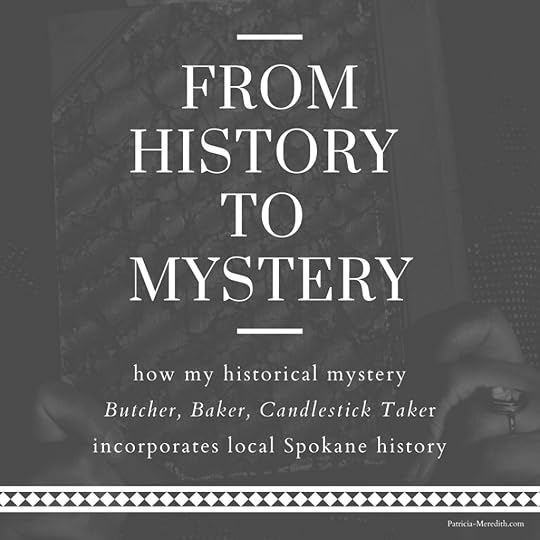
My historical mystery The Butcher, the Baker, the Candlestick Taker is the first in a series of murder mysteries set in Spokane in 1901.
Archie Prescot has traveled across the country to Spokane, Washington to design the clock tower for the new Great Northern Railroad depot. When his talent for creating unique clock chimes connects him with a local patroness, he is thrilled, until she is found beheaded in the workshop of his new colleague. Her grand home on the South Hill provides ample suspects, as Archie works with his landlords, Detective Carew and his twin brother, to prove his fellow inventor, a blind Japanese man, and himself innocent of the crime. While on the hunt for the murderer, romance crops up when a young lady crosses his path with a mysterious past of her own. Six intersecting storylines create a cohesive look at a convoluted murder that will require all points of view to discover the truth.
When it came to the actual creation of the novel, the research and writing were so integral it hasn’t been a matter of researching and then writing, but more of a back and forth, push and pull.
Throughout the novel, I’ve attempted to stay true to Spokane’s history, including people. For example, the coroner and lawyer involved are real people, and are even visited in their actual locations from the time, which I found in the Spokane City Directory from 1901. Every member of the police, other than my lead detective and his brother, are actual officers of the time. The locations visited in the book are either real locations still capable of being visited or are inspired by a place you can still visit. (Click here to view a map where I’ve marked all the locations of the book.) Important events, like the Great Spokane Fire of 1889 or the arrival of the first electric automobiles, are referenced and influential to the book’s plot. But I’m getting ahead of myself. Let’s go back to the beginning…
I ended up dividing my research between four central areas:
hands-on researchfirst-hand accountssecond-hand research and finally, expert readers.Hands-On ResearchAs I mentioned in my blog about why I chose Spokane, I began with the Campbell House. After speaking with the docents there, they told me to talk to the Ferris Archives next door. I set up a time to come in and research after learning that the person now in charge of the archives was Anna Harbine, a girl I actually already knew from Whitworth University days! (Typical Spokane—everyone is connected!) Then I was told to try the Northwest Room.
It was here I found the basis for what I needed. I didn’t have a specific date yet, just knew 1901. So I was thrilled to discover the construction of the iconic clock tower began in 1901!
Because of the fight to keep the depot during the Expo 74 building, a lot of the information I needed had already been collected for me. Then I just had to track down each of the original sources and newspaper articles, which led me to more and more detailed descriptions of the building.
One of the things I noticed was the designer of the clock for the tower is listed as Seth Thomas, a company in Connecticut, but there was no name associated with it.
I realized one of my characters was perfect to play the part of the designer of the clock for the tower.
And from there it just kept trickling down until each of my characters were so connected to Spokane it was clear this was where they belonged.
Other hands-on research included:
Visiting the Campbell House, as stated before.Visiting the Inland Northwest Rail Museum out in Reardan, so I got to walk through actual trolley cars and train cars and see locomotives from my time period.Walking around Manito gave me ideas for scenes set there.A Mother’s Day walking house tour, which gave me more ideas for the design of the house.And walking around downtown, including visiting the clock tower itself!First-Hand AccountsI wanted to get as much as I could from first-hand accounts, from people who actually lived and breathed and saw Spokane in my time period.
Dear Mother, as I’ve written about before, was extremely helpful in providing first-hand impressions of Spokane, its people, its environment, and its culture in 1901.
When I found Spokesman-Review articles here, it blew my mind. There’s nothing quite like reading articles from the time period to get the creative juices flowing! When I first began to research, I hadn’t picked a date, so I just started browsing articles from around when the clock tower had begun construction, which gave me more ideas for things that could affect my characters, and led me to pick Monday, April 15 as the first day of my book.
The Polk’s City Directory for 1901 and 1902 were really helpful in providing actual addresses and locations of people and places in Spokane in 1901. The Sanborn Maps from that era were also helpful in locations.
The History of Spokane County by Jonathan Edwards, published in 1900, has helped me to describe people and places from that time period, as well as The History of the City of Spokane and Spokane County by N.W. Durham, published in 1912.
Cookbooks from the era were also incredibly influential in many scenes and characters in the books. I shared more about that in these three blogs:
CookingCleaningHome HealthAlso at the Ferris Archives I found diaries, letters, oral histories, and more from Spokanites, including the Campbells, from 1901.
Second-Hand AccountsI next moved to nonfiction historical research, to fill in all the gaps, and to get even more inspiration. This included books and websites like:
Spokane’s Street Railways: An Illustrated History by Chas. V. Mutschler, Clyde L. Parent, and Wilmer H. Siegert.Life Behind the Badge: The Spokane Police Department’s Founding Years, 1881-1903 by Tony and Suzanne Bamonte, with the Spokane Police Department History Book Committee.Anything by the Bamontes, including Manito Park: A Reflection of Spokane’s Past, Spokane: Our Early History, and Spokane and the Inland Northwest Historical Images.Saga of a western town…Spokane by Jay J. Kalez.Influential Women of Spokane by Nancy Driscol Engle.Show Town by Holly George.Our City Spokane by Marcia O’Neill Schrapps and Nancy Gale Compau.Nostalgia Magazine articles too numerous to name.SpokaneHistorical.orgHistoryLink.orgTheLocalHistory.com by Logan CamporealeI also found this Google “map” someone had made of the streetcar routes through Spokane, which I then used to ensure my characters were getting off and on at actual locations, in addition to using it to create my own map of locations in my book. (If someone knows who made it, I’d love to credit them by name in my acknowledgments!)Not to mention all the books I came across that I’ve marked as ones I’ll need to return to for sequels!
Expert ReadersOne of the last things I did was to have experts read my book for accuracy. This happened a few times throughout the writing process.
The wonderful Susan Walker, the head of the Spokane Regional Law Enforcement Museum Archive, signed off on my book for historical accuracy regarding the police side of things.
I also had Logan Camporeale read it, who was the head of the Campbell House docent program and was managing the Ferris Archives at the time of my research. He only commented on two points, which I fixed!
I spoke with a blacksmith to ensure accuracy in that aspect. Robert Silvan offered me great details about his work with the old, original forges, making appearances at the Spokane Ren Faire and writing conferences. He also turned out to be an expert in Japanese history, having lived and studied in Japan for two years, to learn how they did blacksmithing, which was perfect as my blacksmith, Hayate Matsumoto, is Japanese. He also worked with me to figure out how he could be blind, which was an idea that had struck me early in my writing, though I wasn’t certain then how that would work, even if it would work. Thankfully, we worked out how to make it possible and believable while remaining true to the historical way of blacksmithing.
My husband worked at Pounder’s Jewelry at that time, so he was able to hook me up with their highly trained and skilled clockmakers, who gave me incredible insight and details into the art of clockworks.
In ConclusionI could go on! All this to say, I really wanted to make sure my book was historically accurate where it needed to be, so that readers would be more likely to go with me on the murder plot, which is fictitious.
On the first book, I often became distracted by my research, falling down rabbit trails of information or spending far too much time reading newspaper articles—they’re really SO FASCINATING!—and then ending up with more research than I could possibly use. But every new thing I learned impacted the book!
For example, one of the things I learned during a rabbit trail read through newspaper articles was that President William McKinley was scheduled to visit Spokane and stay with the Campbell’s a couple weeks after the events of my first book. So guess what event is central to the plot of the sequel??
I’ve also started a list of Spokane locations, events, and people that I’d like to have appear in future books in the series.
So, if you know people who appreciate historical accuracy when it comes to fiction, be sure to tell them about my book, coming THIS FALL: Butcher, Baker, Candlestick Taker, the first in the Spokane Clock Tower Mysteries.
For the latest updates, be sure to follow me as @pmeredithauthor (Facebook, Instagram, and Goodreads).
Thank you for reading!
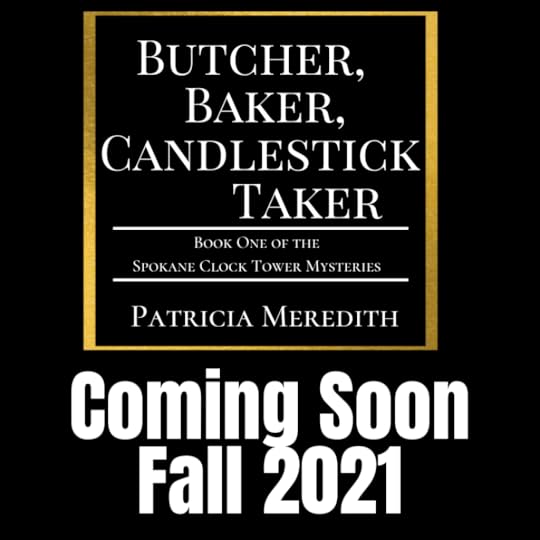
The post History to Mystery appeared first on Patricia Meredith, Author.
May 24, 2021
Publication Day for Happenings

Happy publication day! Today Happenings, my first book of poems, is published!
To purchase a copy, head to books2read.com/happenings to order from your favorite ebook retailer. You can also ask about it at your local library, as more requests lead to libraries getting a copy to make available!
I’m working hard on getting everything ready to go for the Fall release of Butcher, Baker, Candlestick Taker, the first in my historical mystery series set in Gilded Age Spokane. But I decided to share this book of poems with you to tide you over.
Anna Katharine Green, author of The Leavenworth Case and inspiration to the likes of Sir Arthur Conan Doyle, Agatha Christie, and Dorothy L. Sayers, also published poetry, though it was her mystery novels that made her famous, so I thought it would be fun to follow in her footsteps!
These poems have come to me over the years, though they’re primarily from the months before and after I met my husband, Andrew Meredith. Through them, I hope you’ll find feelings of longing, seeking, discovery, and love.
Here are a few excerpts from Happenings, to whet your appetite:











I’m so excited to share these poems with you! I hope the words speak to you when you need them most…

Remember: if you sign up for my newsletter, you’ll be the first to hear when I publish something new! (And you’ll get a free short story I wrote, based on an article from The Spokesman-Review!)
The post Publication Day for Happenings appeared first on Patricia Meredith, Author.
May 11, 2021
Home Health Quotes from 19th Century Cookbooks

Over the past two weeks, I’ve shared some of the cooking and cleaning quotes from 19th century cookbooks that inspired my book, Butcher, Baker, Candlestick Taker, and in particular the characters of Mrs. Curry (cook) and Eleanor Sigmund (maid).
But cookbooks of the time didn’t contain just cooking and cleaning tips. They also included home health remedies—the sorts of things you’d find classified under “natural” or “homeopathic” on Pinterest these days.
I’ve shared some of my favorite home health quotes below in a slideshow taken from a presentation I used to give at local libraries. Just click on the arrows to either side and you should be taken to the next slide. 

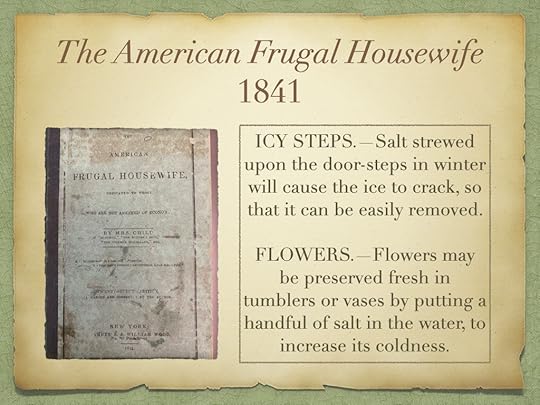
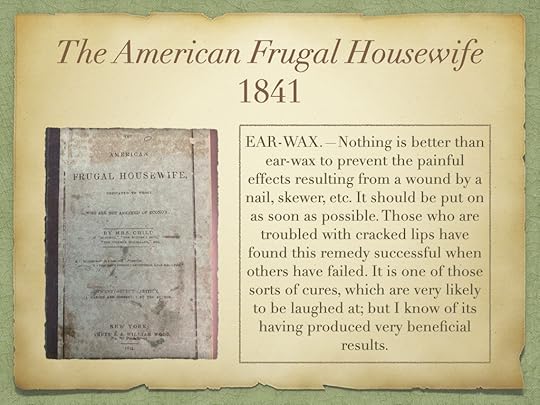
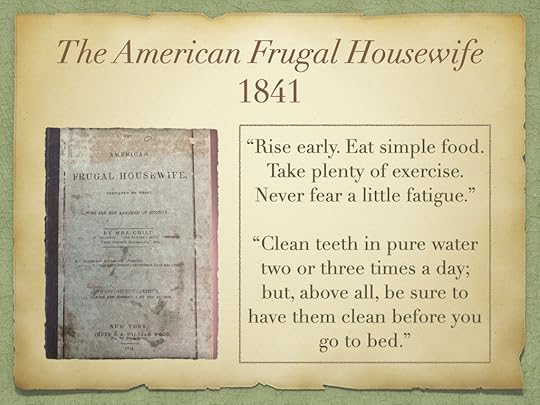
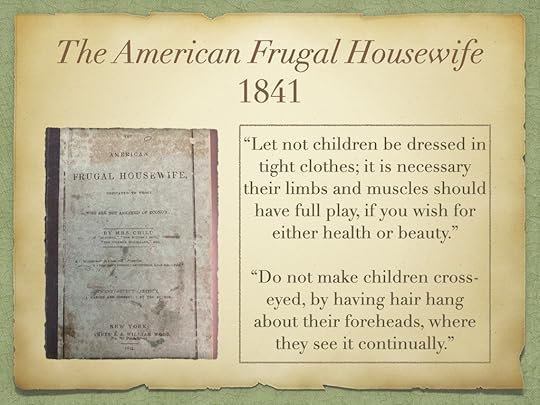
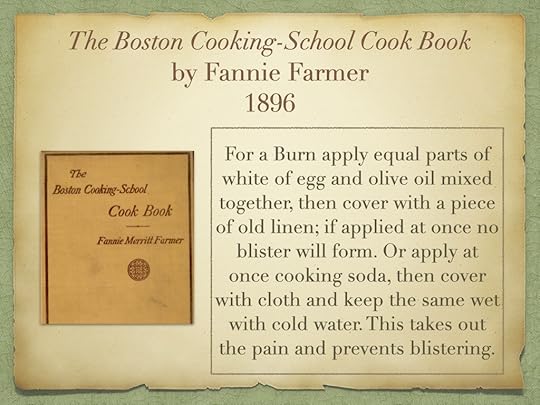
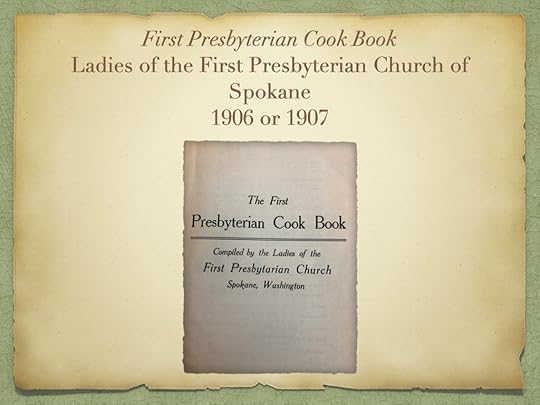
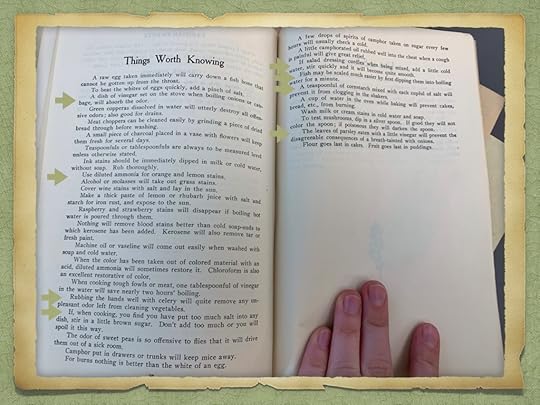
The third slide always makes me laugh: earwax??!! Can’t say I’ve tried this, but it does make you wonder! I actually had someone at one of my presentations say they’ve done something similar before: they put earwax behind their ears to cure earache! Something their mother taught them!
The sixth slide, a quote from Fannie Farmer’s Boston Cooking-School Cookbook (1896), inspired a scene in my book:

To finish, every cookbook usually included such helpful things for the future writer like this passage detailing “How to Build a Fire” from Fannie Farmer’s Boston Cooking-School Cookbook (1896): “Before starting to build a fire, free the grate from ashes. To do this, put on covers, close front and back dampers, and open oven-damper; turn grate, and ashes will fall into the ash receiver. If these rules are not followed, ashes will fly over the room. Turn grate back into place, remove the covers over fire-box, and cover grate with pieces of paper(twisted in centre and left loose at the ends). Cover paper with small sticks, or pieces of pine wood, being sure that the wood reaches the ends of fire-box, and so arranged that it will admit air. Over pine wood arrange hard wood; then sprinkle with two shovelfuls of coal. Put on covers, open closed dampers, strike a match,–sufficient friction is formed to burn the phosphorus, this in turn lights the sulphur, and the sulphur the wood,–then apply the lighted match under the grate, and you have a fire.”

You can learn more about my historical mystery, Butcher, Baker, Candlestick Taker, here. Be sure to add the book to your Goodreads Want to Read List so you’ll know when I reveal the cover and the book is available for pre-order! You can also follow me on Instagram, Facebook, or sign up for my newsletter for all the latest updates!
Thank you for reading!
For a wonderful collection of archived cookbooks from throughout the centuries, check out: https://digital.lib.msu.edu/projects/cookbooks/html/browse_date.cfmA Feast of Good Things, Prepared by the Ladies of First Presbyterian Church of Spokane, WA, Published 1895 (Pictures my own, taken with permission by the Ferris Archives.)The American Frugal Housewife, by Mrs. Lydia Maria Child, Published 1841 https://d.lib.msu.edu/fa/33#page/8/mode/2upThe American Weekly’s Cookbook, by Isabel Gordon Curtis, Published 1909 (Pictures my own, taken with permission by the Ferris Archives.)Epicurean Cookbook, Published 1894 https://d.lib.msu.edu/fa/26#page/1/mode/2upFannie Farmer’s Boston Cooking School Cookbook, Published 1896 https://d.lib.msu.edu/fa/8#page/2/mode/2upThe First Presbyterian Cook Book, Prepared by the Ladies of First Presbyterian Church of Spokane, WA, Published 1906 or 1907 (Pictures my own, taken with permission by the Ferris Archives.)The Home Cook Book, Published 1877 (Pictures my own, taken with permission by the Ferris Archives.)Mrs. Rorer’s New Cook Book, Published 1902, Originally published in 1886 https://d.lib.msu.edu/fa/63#page/1/mode/2upPractical American Cookery and Household Management, by Julie Corson, Published 1886 https://d.lib.msu.edu/fa/58#page/1/mode/2upThe Settlement Cookbook, by Mrs. Simon Kander, Published 1901 https://d.lib.msu.edu/fa/66#page/1/mode/2upWoman Suffrage Cook Book, by Hattie A. Burr, Published 1886 https://d.lib.msu.edu/fa/74#page/6/mode/2upThe post Home Health Quotes from 19th Century Cookbooks appeared first on Patricia Meredith, Author.
May 4, 2021
Cleaning Quotes from 19th Century Cookbooks

Last week I shared some cooking quotes from 19th century cookbooks that inspired my book, Butcher, Baker, Candlestick Taker, in particular the menus cooked by Mrs. Curry.
This week I’d like to share some of the cleaning tips I gleaned through my research, many of which I incorporated into the daily duties of my maid character, Eleanor Sigmund.

For example, this quote was inspired by this detail shared in Fannie Farmer’s Boston Cooking-School Cookbook, 1896: “To prevent Glassware from being easily broken, put in a kettle of cold water, heat gradually until water has reached boiling point. Set aside; when water is cold take out glass. This is a most desirable way to toughen lamp chimneys.”

These two scenes were inspired by lines found in Miss Corson’s Practical American Cookery and Household Management, 1886.

I’ve shared some more great quotes below in a slideshow format, taken from a presentation I used to give at local libraries. Just click on the arrows to either side and you should be taken to the next slide. 






The last slide makes an excellent segue into next week’s collection of quotes: Home Health…
You can learn more about my historical mystery, Butcher, Baker, Candlestick Taker, here. Be sure to add the book to your Goodreads Want to Read List so you’ll know when I reveal the cover and the book is available for pre-order! You can also follow me on Instagram, Facebook, or sign up for my newsletter for all the latest updates!
Thank you for reading!
For a wonderful collection of archived cookbooks from throughout the centuries, check out: https://digital.lib.msu.edu/projects/cookbooks/html/browse_date.cfmA Feast of Good Things, Prepared by the Ladies of First Presbyterian Church of Spokane, WA, Published 1895 (Pictures my own, taken with permission by the Ferris Archives.)The American Frugal Housewife, by Mrs. Lydia Maria Child, Published 1841 https://d.lib.msu.edu/fa/33#page/8/mode/2upThe American Weekly’s Cookbook, by Isabel Gordon Curtis, Published 1909 (Pictures my own, taken with permission by the Ferris Archives.)Epicurean Cookbook, Published 1894 https://d.lib.msu.edu/fa/26#page/1/mode/2upFannie Farmer’s Boston Cooking School Cookbook, Published 1896 https://d.lib.msu.edu/fa/8#page/2/mode/2upThe First Presbyterian Cook Book, Prepared by the Ladies of First Presbyterian Church of Spokane, WA, Published 1906 or 1907 (Pictures my own, taken with permission by the Ferris Archives.)The Home Cook Book, Published 1877 (Pictures my own, taken with permission by the Ferris Archives.)Mrs. Rorer’s New Cook Book, Published 1902, Originally published in 1886 https://d.lib.msu.edu/fa/63#page/1/mode/2upPractical American Cookery and Household Management, by Julie Corson, Published 1886 https://d.lib.msu.edu/fa/58#page/1/mode/2upThe Settlement Cookbook, by Mrs. Simon Kander, Published 1901 https://d.lib.msu.edu/fa/66#page/1/mode/2upWoman Suffrage Cook Book, by Hattie A. Burr, Published 1886 https://d.lib.msu.edu/fa/74#page/6/mode/2upThe post Cleaning Quotes from 19th Century Cookbooks appeared first on Patricia Meredith, Author.

